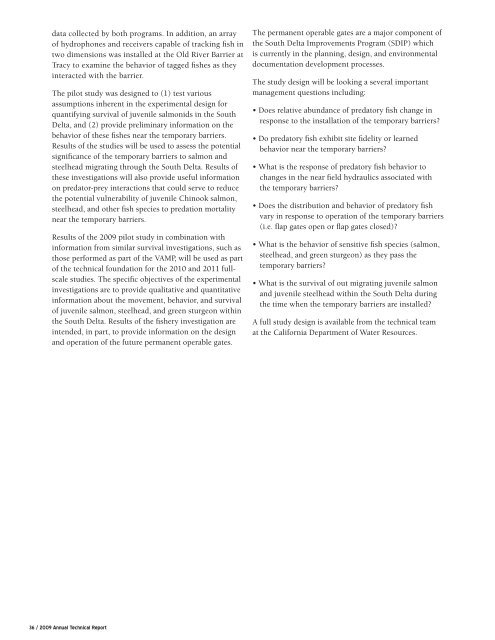Head OF Old riVer Barrier installatiOn and FlOWs - San Joaquin ...
Head OF Old riVer Barrier installatiOn and FlOWs - San Joaquin ...
Head OF Old riVer Barrier installatiOn and FlOWs - San Joaquin ...
Create successful ePaper yourself
Turn your PDF publications into a flip-book with our unique Google optimized e-Paper software.
data collected by both programs. In addition, an array<br />
of hydrophones <strong>and</strong> receivers capable of tracking fish in<br />
two dimensions was installed at the <strong>Old</strong> River <strong>Barrier</strong> at<br />
Tracy to examine the behavior of tagged fishes as they<br />
interacted with the barrier.<br />
The pilot study was designed to (1) test various<br />
assumptions inherent in the experimental design for<br />
quantifying survival of juvenile salmonids in the South<br />
Delta, <strong>and</strong> (2) provide preliminary information on the<br />
behavior of these fishes near the temporary barriers.<br />
Results of the studies will be used to assess the potential<br />
significance of the temporary barriers to salmon <strong>and</strong><br />
steelhead migrating through the South Delta. Results of<br />
these investigations will also provide useful information<br />
on predator-prey interactions that could serve to reduce<br />
the potential vulnerability of juvenile Chinook salmon,<br />
steelhead, <strong>and</strong> other fish species to predation mortality<br />
near the temporary barriers.<br />
Results of the 2009 pilot study in combination with<br />
information from similar survival investigations, such as<br />
those performed as part of the VAMP, will be used as part<br />
of the technical foundation for the 2010 <strong>and</strong> 2011 fullscale<br />
studies. The specific objectives of the experimental<br />
investigations are to provide qualitative <strong>and</strong> quantitative<br />
information about the movement, behavior, <strong>and</strong> survival<br />
of juvenile salmon, steelhead, <strong>and</strong> green sturgeon within<br />
the South Delta. Results of the fishery investigation are<br />
intended, in part, to provide information on the design<br />
<strong>and</strong> operation of the future permanent operable gates.<br />
36 / 2009 Annual Technical Report<br />
The permanent operable gates are a major component of<br />
the South Delta Improvements Program (SDIP) which<br />
is currently in the planning, design, <strong>and</strong> environmental<br />
documentation development processes.<br />
The study design will be looking a several important<br />
management questions including:<br />
• Does relative abundance of predatory fish change in<br />
response to the installation of the temporary barriers?<br />
• Do predatory fish exhibit site fidelity or learned<br />
behavior near the temporary barriers?<br />
• What is the response of predatory fish behavior to<br />
changes in the near field hydraulics associated with<br />
the temporary barriers?<br />
• Does the distribution <strong>and</strong> behavior of predatory fish<br />
vary in response to operation of the temporary barriers<br />
(i.e. flap gates open or flap gates closed)?<br />
• What is the behavior of sensitive fish species (salmon,<br />
steelhead, <strong>and</strong> green sturgeon) as they pass the<br />
temporary barriers?<br />
• What is the survival of out migrating juvenile salmon<br />
<strong>and</strong> juvenile steelhead within the South Delta during<br />
the time when the temporary barriers are installed?<br />
A full study design is available from the technical team<br />
at the California Department of Water Resources.


